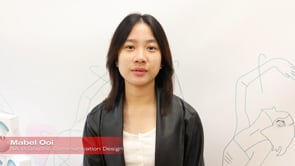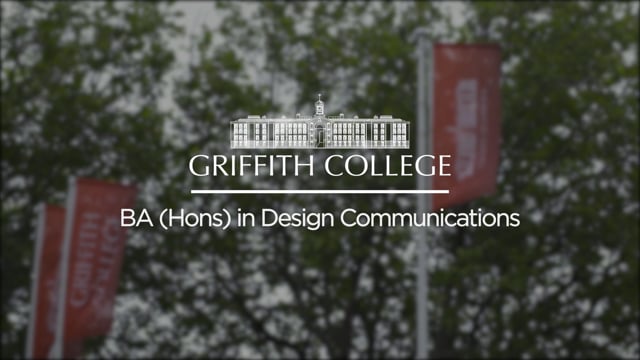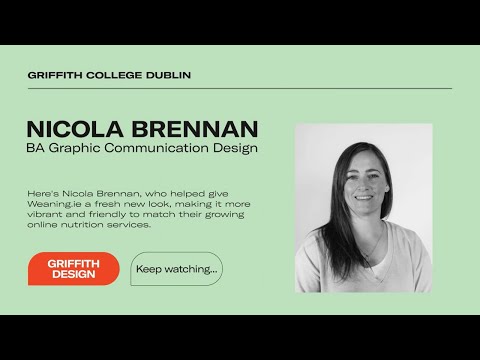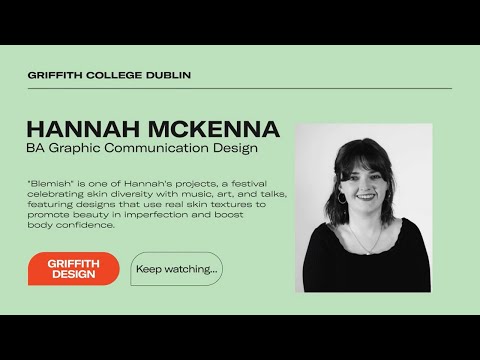BA (Hons) in Graphic Communication Design
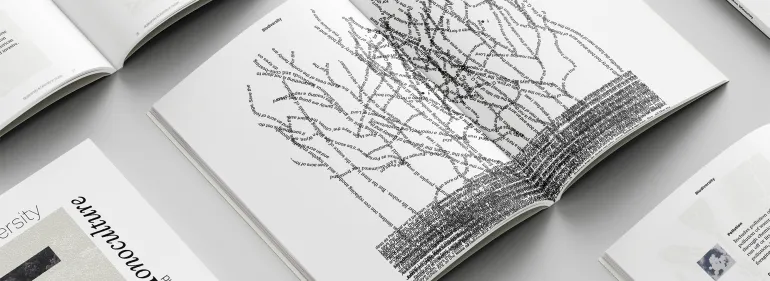
Course Overview
Design your future and bring ideas to life through powerful visuals.
Our BA (Hons) in Graphic Communication Design is a dynamic three-year degree that combines creative exploration with industry insight. You'll develop your own design voice while gaining the skills and strategy needed for today’s visual communication landscape.
Ready to leave your mark? Explore fresh, original work from our Graphic Communication Design students at Griffith Creative 2025

Why Study Graphic Communication Design at Griffith?
- No written exams – 100% continuous assessment.
- Create a standout design portfolio across print, digital, and motion.
- Work on live briefs from real clients and industry collaborators.
- Build essential skills in branding, UX, marketing, and entrepreneurship.
- Be inspired by field trips to major design hubs across Europe.
- Learn from award-winning practitioners and industry-active lecturers.
- Showcase your work during our annual Creative Week.
- Develop future-proof creative thinking and problem-solving skills.
- Join a community of designers making waves across agencies, studios, and startups.
Course Highlights
- Small Class Sizes, Big Support
Get personalised feedback and mentorship in a close-knit, collaborative environment. - Hands-On Studio Experience
Develop practical skills in fully-equipped design studios. - Learn from Industry Professionals
Be taught by designers, makers, and creatives with real-world experience. - Showcase Your Work at Griffith Creative Week
Present your final-year projects to industry, peers, and the public. - Field Trips & Real-World Inspiration
Explore exhibitions, studios, and design briefs to fuel your creativity.
Questions? Have a look at our FAQ section.
Intake Dates
- Dublin - Full-Time - September 2026
Are you applying through the CAO?
Check out our CAO HUB for more information about applying through the CAO!
Course Codes
- Dublin: GC462
What our students say

The course was so broad and offered a lot of options for the future. We went on several field trips and had industry experts come in to speak, which was really valuable. We gained great insights and learnt so much from those experiences.
Graphic Communication Design

I really enjoyed the process, especially seeing CoLab Packaging to see how different items are produced. I also liked all the talks from the different guest speakers. Working alongside my classmates and getting feedback from Ashland was great for tailoring and improving our future designs. The feedback we received was always very constructive.
Graphic Communication Design
Course Details
Year One
This module equips learners with the skills to achieve creative design solutions by formulating a problem-solving approach and to successfully represent their vision. Learners work through project briefs which introduce various stages of design including: research, concept and design development, selection and presentation skills. Learners develop drawing skills and appropriate design research methods to develop original concepts to inspire creativity and personal creative ideas to projects.
This module introduces the role of typography within design communication. Learners gain an understanding of the importance and significance of typography and why it needs to be studied and leveraged in practice. Learners are taught basic attributes, vocabulary, and best practices associated with typography. It introduces learners to the basic language and principles of typography and its use. It concentrates on building skills and abilities of spatial arrangement in the layout of text in relation to other design elements.
This module aims to enable learners to develop skills in the use of selected software through experimenting with software through the use of montages, layout and other presentation skills. The module also develops the learners’ understanding of graphic design, the use of colour, type, imagery and layout. The module helps learners to focus and hone their design skills and gain practical experience in desktop publishing and illustration packages. Another objective of the module is to develop learners’ skills in the use of design principles and layout for print communicating design ideas.
The module explores the scope and context of the illustrator’s practice and the practicalities of illustration as a business. Learners explore a wide variety of creative processes to develop a robust visual language. Learners recognise best practice by establishing and reinforcing the process of briefing, research, idea development and execution, together with exercises and workshops covering an extensive range of media, techniques and processes. This supports an in-depth understanding and knowledge of the discipline of illustration.
This module introduces contextual studies through the key designers, styles and periods to trace the evolution of communication design in its social, economic and political contexts from the mid-19th century up to the present. The module introduces academic referencing, essay research and structure and writing skills, enabling learners to establish their voice in an academic environment.
This module equips learners with the skills to achieve creative design solutions by formulating a problem-solving approach and successfully representing their vision. Learners work through project briefs which introduce various stages of design including: research, concept and design development, selection and presentation skills. Learners develop their drawing skills and use appropriate design methods to inspire creativity and turn them into projects.
This module introduces the role of photography within communication design. It introduces learners to the materials, techniques and terminology related to specific creative and technical processes in photography and advertising. It introduces the learners to creative photography for newspapers, magazines, publishing and design agencies. Development of creative thinking, ideas generation, brief solving and shooting to fit a layout are also incorporated.
This module enables learners to develop skills in Adobe suite tools and printing by experimenting with software through the use of montages, layout and other presentation skills. The objectives are also to develop learners’ understanding of graphic design, the use of colour, type, imagery and layout. Learners hone their design skills and gain practical experience in desktop publishing and illustration packages too.
The module explores the scope and context of the illustrator’s practice and the practicalities of illustration as a business. Learners explore a wide variety of creative processes to develop a robust visual language and examine a wide variety of creative processes. Learners recognise best practice by attending internal and external workshops, which reinforce the process of briefing, research, idea development and execution, together with exercises covering an extensive range of media, techniques and processes. This supports an in-depth understanding and knowledge of the discipline of illustration.
This module provides a common core of design culture and theory taken by all learners on the design undergraduate programmes. This module brings together learners from all undergraduate programmes to give learners the opportunity to engage in analysis of their own and others’ ideas in a challenging and creative environment.
Year Two
Communication Design 3 is the core study area, learners become familiar with the basic skills, tools and techniques used throughout the design process. This module introduces the learner to the concepts and principals of contemporary visual identity design. It includes differentiating between visual styles and corporate structures. Learners will create visual design solutions to set logo and visual identity briefs. The module also explores communicative branding graphics and 3-D forms for packaging design. Practical design classes encourage students to recognise contemporary packaging design values through analysis of visual research and to interpret visual form and function as related to packaging design.
Typography 2 is the core study area, learners in Typography 1 will have become familiar with the basic skills, language and principles throughout the communication design process. This module explores the communicative value of typography with an emphasis on conceptual, practical and expressive values of type in graphic design. In addition, this module encourages the understanding of the application of typographic information in Graphic Communication Design and also explores experimentation with the treatment of type in order to communicate a message. Through answering set briefs, emphasis is on choosing and developing typographic treatments appropriate to the message using techniques such as mixed media, hand-rendering and organic/digital distortion.
This module equips learners with the skills to achieve creative design solutions by formulating a problem-solving approach and to successfully represent their vision through basic code. Learners work through project briefs which introduce various stages of design and development. The internet has become the dominant medium by which digital media is delivered and used worldwide. This module explores the web as a channel of communication, looking at technology, design, business and cultural issues. Through a range of practical assignments, learners engage with different types of web applications and develop practical skills used for the design and management of online communication.
The design futures module is designed with the intention of accommodating emerging methodologies, knowledge and skills, which are developing as a response to the increasing complexity of contemporary culture and design practice.
There are opportunities for the learners to critically analyse, debate and address key current issues associated with design as they relate to their discipline-specific practice. The module is designed to challenge and develop learners’ abilities to critically reflect upon competing concepts and contemporary debates associated with design and related creative practices, as well as their impact within local and global contexts.
This module provides learners with an understanding of the role and principles of marketing for a start-up business. Learners appreciate when and how marketing is applied in the creative industries, learn about market segmentation, targeting and positioning and assist learners to analyse all aspects of the traditional marketing mix. Learners conduct basic marketing research, analysis and learn how to apply research findings to specified business projects. The module enables learners to articulate and interact with audiences, effectively communicating ideas and work in a range of situations.
This module equips learners with the skills to achieve creative design solutions for branding and advertising by formulating a problem-solving approach and to successfully represent their vision. Learners engage with brand management theory and apply this in critical evaluation of brand communication and the value of effective branding to organisations. Learners are also taught about branding in a marketing context (in particular consumer behaviour, advertising and PR).
In the second half of the module, learners are introduced to the practice of advertising and the advertising industry. It is predicated on the idea that advertising is fundamentally a communication industry and as such reflects some of the key academic, social and practical ideas which shape communication as an important activity in society.
This module surveys the key principles and processes of human-centred interaction design across a range of contexts: from screen, software applications and products to constructed environments. In a studio environment, learners experience an overview of the discipline and of the different professional roles a designer may play. Learners develop skills in sketching the user experience through low-fidelity prototyping techniques such as paper, slideshow, animation and simple interaction.
This module enables learners to develop photography and video skills so they can apply them to their design projects. The objectives are to enable learners to develop skill in the use of digital cameras for photography and video, and explore industry standards in this area. It introduces the basic principles of photography and video with the emphasis being on images within their design studio practice.
This module enables learners to explore entrepreneurial aspirations and abilities by examining entrepreneurial theory, research and process. The objectives are to foster critical thinking around applying creativity and innovation to the businesses within their particular area of study: fashion / interior / design communication / animation / gaming.
Year Three
Communication Design 5 is the core capstone design module, it is project led and is the key integrative programme module with all other modules assignments feeding into and supporting the projects. This module aims to enable you to identify and deliver a practice-based research project related to your studio practice, which will explore the dialogue between theory and practice. Learners are encouraged to develop an individual graphic design style and working methodology that goes beyond the standards required by industry and postgraduate study. The module consolidates abilities with the focus on creativity, skill and professional practice.
This module builds on the design skills and basic software knowledge that the learners have gained in Web Design 1 and the Interaction Design modules. It aims to advance the learners’ skills and knowledge in accessibility, responsive design, using web frameworks such as Bootstrap and Foundation. This module aims to equip learners with the skills to achieve creative web design solutions by formulating a problem-solving approach and to successfully represent their vision. Learners are provided with skills in web design, marketing and digital media design practice.
This module is about creating animated motion graphics sequences from static, two-dimensional visual content. Learners are introduced to fundamentals of 2D and 3D animation from conceptualisation, design through to creation. Motion graphic products are also examined. Learners develop a library of thematically linked visual assets and learn a workflow and process for animation, to enable the learner to animate the layered graphics and create motion graphics sequences. This module aims to equip learners with the skills to achieve creative design solutions by formulating a problem-solving approach and to successfully represent their vision.
The aim of the module is to enable the learner to carry out a primary piece of research in the form of a literature review and to develop their own area of special interest in design through a series of presentation methodologies. The objective is to compile an 8,000 word thesis submitted in support of candidature for the BA (Honours) Level 8 degrees. Learners are allocated a supervisor by the programme leader.
The aim of this module is to place the learner at the centre of the learning experience to make fully supported, negotiated choices about the direction and composition of the major project. The objective of the major project is for the learner to work in a self-directed manner towards a substantial piece of original creative work. Through a process of research and discussion with academic staff, learners determine a body of self-directed study that allows them to develop a personal area of interest related to the field visual communication design.
This module helps learners to develop their experience of the professional workplace, competitive and/ or exhibition practice and the legal and ethical frameworks surrounding them through participation in live competition or live projects. The module sets out to prepare learners for entry to the workplace or higher study through experience of professional portfolio development and related promotional activities. It helps learners to assess not only their position within the design industry but also to define their individual creative strengths and present work to a high professional standard.
Timetables
Full-Time Programme:
Monday to Friday from 10 AM - 5 PM.
Timetables are subject to change. For the most up-to-date information, please contact the faculty directly.
How to Apply
Entry Requirements
All applicants for this course must submit a general art and design portfolio.
Portfolio Requirements:
All applicants to this programme are required to submit a general art and design portfolio, demonstrating creativity and observational drawing skills through the development of creative project work. Our portfolio guidelines are available here.
Please upload your portfolio using this platform: here
All candidates are required to upload a digital portfolio. Before you begin, you will need a CAO Application Number or a Griffith College application number so please make sure you have made an application to the CAO or Griffith College (as appropriate) for one of our Honours degree programmes.
Deadline: Candidates will have the opportunity to select an assessment date when uploading their portfolio. You must upload your portfolio by your chosen date.
- Friday 27th February 2026
- Friday 27th March 2026
- Friday 24th April 2026
- Friday 29th May 2026
- Friday 26th June 2026
If you have a query or you require further information about submitting a portfolio, please contact [email protected].
Irish/EU applicants who are under 23 years of age on January 1st of the year must apply through the CAO. Please consult the CAO website for information on important application dates.
Students will need a minimum of 2 H5 and 4 O6/H7 grades, to include a language (English, Irish or another language) and either Art or Maths.
CAO Code
Dublin - GC462
Applicants over the age of 23 years on or before the 1st January of the year must apply as a mature student directly on our website. Mature students will be asked for a copy of their passport.
The admissions team will contact the applicants directly.
For advanced entry onto the course, please apply directly and a member of our team will be in contact to discuss your application.
To apply to Griffith College as an international student, please complete an online application form (click Apply Through Griffith below), provide proof of ID, academic transcripts, and demonstrate English language proficiency if applicable.
If English is not a first language, proof of English proficiency is required. For more information, please visit here.
Level 5 holders:
Candidates with a Level 5 qualification in a cognate area who obtain 3 distinctions and 5 passes (plus a portfolio) may be eligible for entry into year 1 of this course. Candidates under 23 years of age still need to apply through the CAO. Mature students can apply directly here.
Level 6 holders:
Applicants with a Level 6 qualification in a related discipline may be eligible for advanced entry into this course. Candidates will be asked to provide relevant transcripts and a portfolio of work in support of their application. Pending the strength of the portfolio, candidates may be eligible for entry into year 1 or year 2 of this programme.
All candidates with a Level 6 qualification, regardless of age, will need to apply directly here.
*Please note, advanced entry applications are assessed on a case-by-case basis and offers are made at the discretion of the faculty.
Fees
For purposes of fee calculation, residence is counted from the time of application.
Please note that not all study modes may be offered at all times. For confirmation, refer to the intake dates in the Overview tab.
Tuition Fees
Study Mode: Full-Time
| Year 1 | Year 2 | Year 3 | |
| Tuition | €7,100 | €6,850 | €6,700 |
| Admin | €250 | €250 | €250 |
| LPC | €147 | €142 | €139 |
| QQI | - | - | €200 |
| Total | €7,497 | €7,242 | €7,289 |
*Please note that additional costs for materials and printing apply for this programme, and are not covered by the tuition fee.
Study Mode: Full-Time
Please refer to the Irish/EU Living Abroad Fees section.
Study Mode: Full-Time
Dublin
Non-EU living in Ireland or abroad: Please refer to our Non-EU Tuition Fees section.
Non-EU students: a Student Services and Administration fee of EUR200 is payable each academic year in addition to the fees quoted below.
An Academic Administration Fee of EUR250.00 and a 2% Learner Protection Charge is applicable each academic year.
Flexible payment options
Students wishing to pay their fees monthly may avail of our direct debit scheme. Please view our Fees information page for more information and assistance.
Sponsorship
Is your company paying for your course?
They will need to complete a Griffith College Sponsorship Form and send this to the Student Fees Office:
- Post: Student Fees, Griffith College Dublin, South Circular Road, Dublin 8
- Email: [email protected]
2% Learner Protection Charge
All QQI accredited programmes of education and training of 3 months or longer duration are covered by arrangements under section 65 (4) of the Qualifications and Quality Assurance (Education and Training) Act 2012 whereby, in the event of the provider ceasing to provide the programme for any reason, enrolled learners may transfer to a similar programme at another provider, or, in the event that this is not practicable, the fees most recently paid will be refunded.
QQI Award Fee
Please note that a QQI Award Fee applies in the final year of all QQI courses. To find the relevant fee for your course level, please see the Fees page.
Progression
Academic Progression
By the end of this course, you'll have a strong foundation in design, business, and marketing, along with a comprehensive portfolio. You can continue your studies at Griffith College or pursue postgraduate options elsewhere in Ireland or abroad.
Career Progression
This course provides pathway to a related Master of Arts or a postgraduate study programme at NFQ Level 9. Graduates may consider progressing within Griffith College onto the following programme:
- Graphic Designer
- Web & App Designer
- UX/UI Designer
- Illustrator
- Art Director


